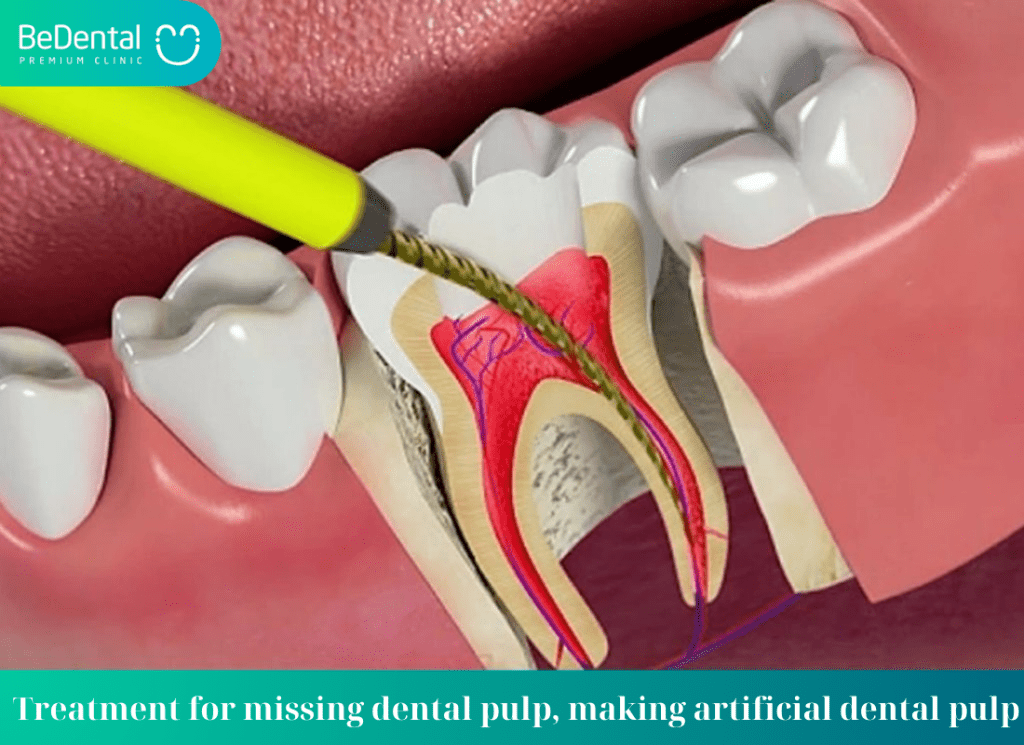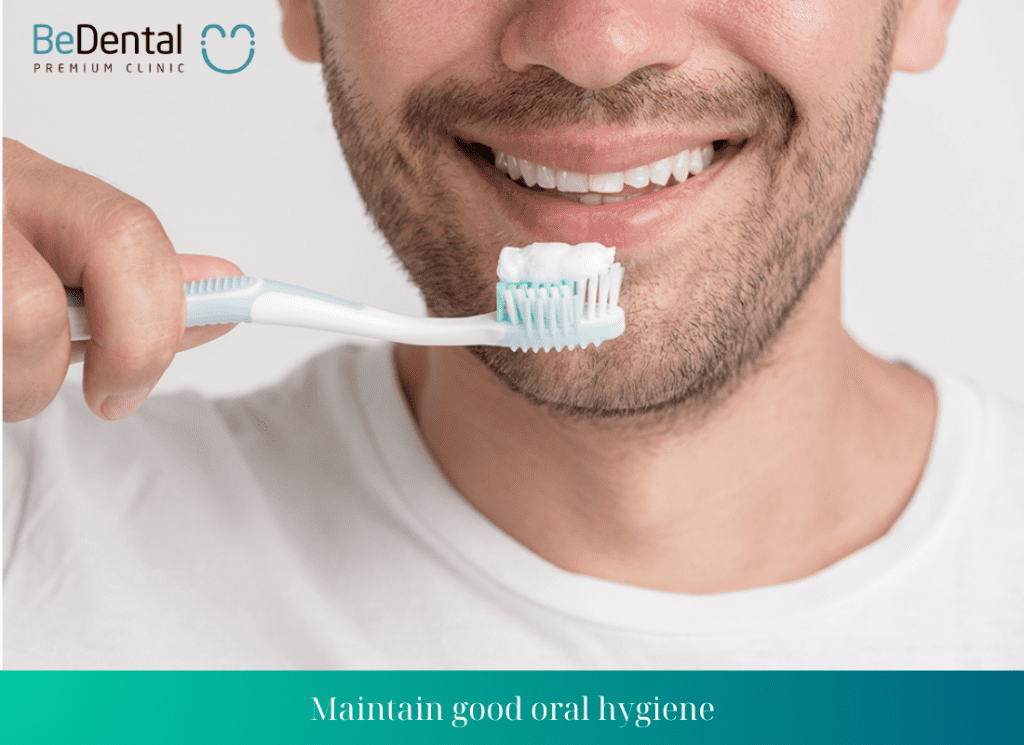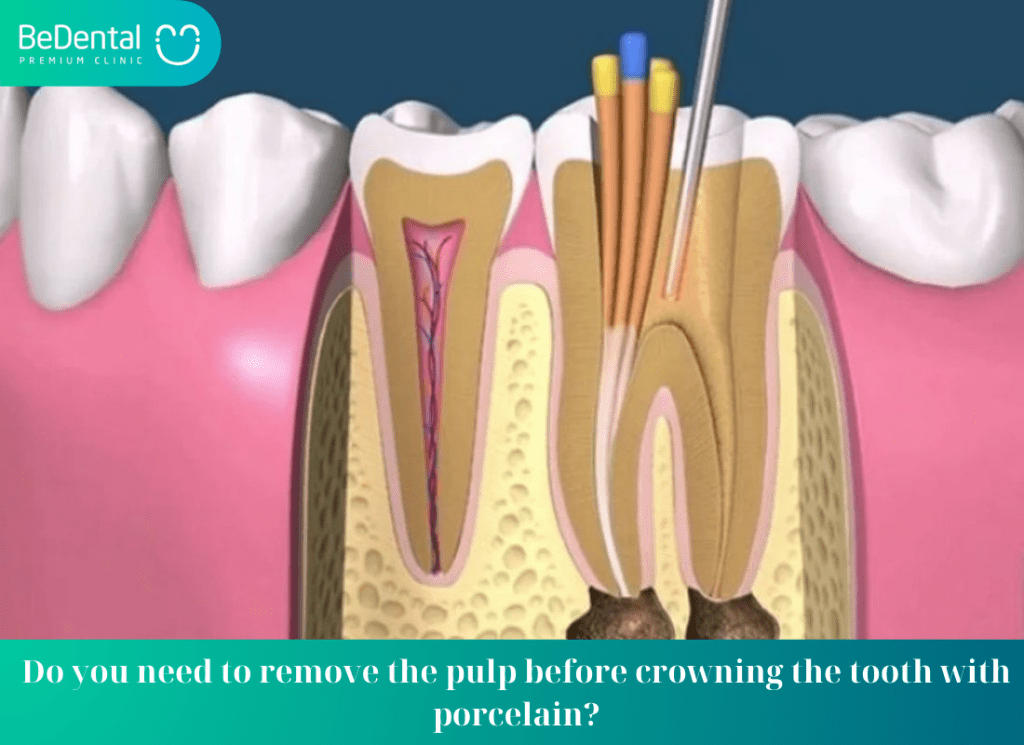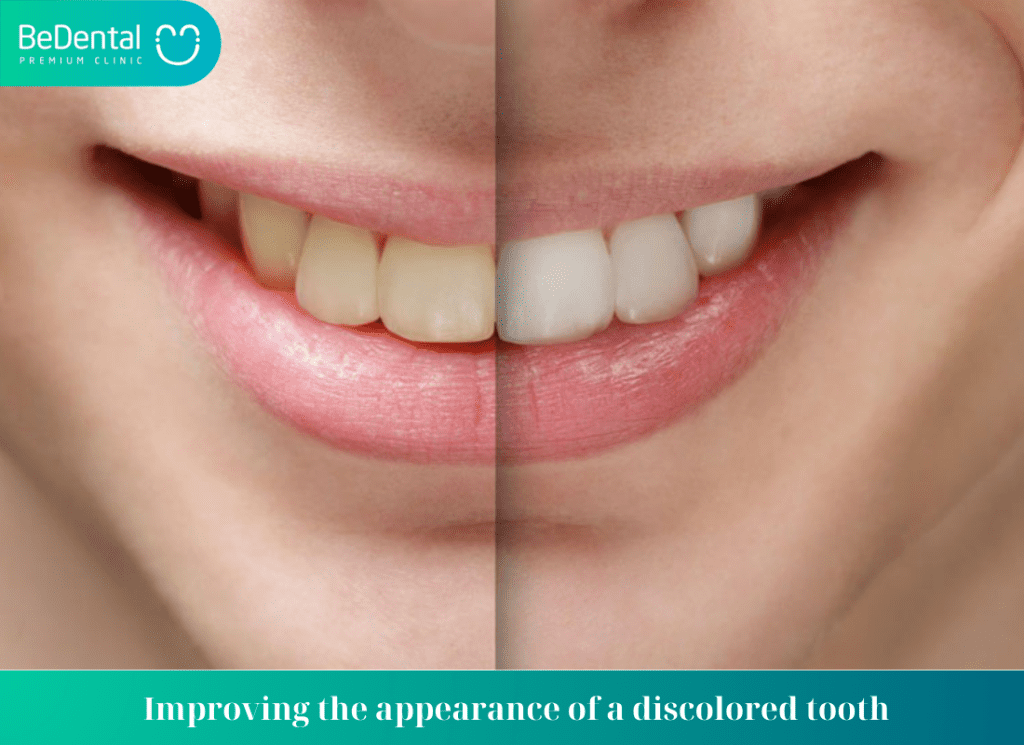What is a dental pulp? Is it necessary to remove the dental pulp when getting a porcelain crown? Let’s find out together with Be Dental through the article below!
Is it necessary to remove the dental pulp when getting a porcelain crown?
The dental pulp is an organ with many blood vessels and nerve fibers in the body of the tooth. The dental pulp is the central part of the tooth made up of connective tissues and pulp cells.
The causes of dental pulp inflammation are:
- Cracked or broken teeth.
- Untreated cavities that allow bacteria to enter the pulp and cause infection.
- Tooth trauma, or heavy impact on the tooth that may have just occurred or may have occurred multiple times in the past.
See more: Should crooked teeth be extracted?

How to remove the dental pulp when getting a porcelain crown
Step 1: Examination and consultation
First, the dentist will conduct a comprehensive oral examination combined with a Cone Beam 3D CT scan to assess the condition of the teeth, pulp, and the inflammation status of the dental pulp.
Once a conclusion is reached, the dentist will discuss with the client about the current state of the teeth, the number of teeth requiring pulp treatment, the treatment plan, and the treatment methods. If the client agrees, the dentist will provide detailed treatment options.
Step 2: Anesthesia- How to remove the dental pulp when getting a porcelain crown
Anesthesia will make the pulp removal process easier, and the client will not experience pain or numbness in the arms or legs during the procedure.
Step 3: Placing a rubber dam- How to remove the dental pulp when getting a porcelain crown
The dentist uses a small plastic dam to cover the tooth that needs pulp treatment, isolating the tooth from the pulp and oral cavity, preventing pulp treatment materials from entering the oral cavity, respiratory tract, or digestive tract.
See more: How many teeth do human have?
Step 4: Pulp removal
The dentist will make a short incision on the chewing surface of the tooth to access the pulp chamber, remove the infected pulp, and disinfect the pulp chamber to eliminate all bacteria.
Step 5: Root canal filling
After treating the pulp inflammation, the dentist will fill the root canal with a specialized filling material to prevent bacteria from causing pulp inflammation again.
To preserve the tooth after pulp treatment, a metal-ceramic crown will be the optimal solution. The ceramic restoration will help maintain and enhance the longevity of the treated tooth, ensuring the ability to chew and improving the appearance of the tooth.
Step 6: X-ray examination
After the pulp removal and crown placement process is completed, the dentist will take a final X-ray to check for any residual inflammation to ensure the effectiveness of the entire treatment process.
Post-pulp treatment oral hygiene
What is Post-pulp treatment oral hygiene? To maintain and ensure the long-term health of the treated tooth after pulp treatment, it is important to follow proper oral hygiene practices and choose appropriate food groups to enhance the longevity of the teeth.
- Maintain a balanced diet, avoid excessive chewing of food, and stay away from environmental irritants such as heat/cold, salty, and sweet foods.
- Avoid using excessive chewing force on teeth that have undergone pulp treatment.
- Brush your teeth correctly according to the dentist’s instructions, use dental floss, and dental picks to remove food debris and plaque.
- Rinse your mouth with saline solution every morning.
- Combine pulp removal with regular dental check-ups to eliminate food debris and diagnose and treat any oral issues early on.

Cases to consider pulp removal
If the tooth is inflamed in stage 2 and stage 3: chronic pulpitis and pulp necrosis, the pulp will not have a chance to recover again.
In these situations, it is necessary to perform pulp removal to end the inflammation and infection. This process does not damage the tooth pulp and surrounding tissues.
Chronic pulpitis stage
The tooth may experience persistent pain for several hours. The gums may also be inflamed, swollen, and contain pus.
Pulp necrosis stage
At this stage, a tooth with pulp necrosis does not cause pain but gradually progresses to pulpitis, periapical abscess, tooth mobility, etc. The tooth may eventually break and fall out of the jaw.
When a tooth is infected while still having some living pulp (meaning the tooth is not completely necrotic), medication or pulp removal may be necessary.
Pulp removal process at BE DENTAL Dental Clinic
The pulp treatment process at BE DENTAL Dental Clinic is carried out meticulously and strictly, involving 5 steps:
Step 1: Comprehensive examination and X-Ray imaging
The dentist will conduct a general health examination to check if the patient has any chronic conditions such as diabetes, cardiovascular problems, blood clotting issues, high blood pressure, etc. If the patient’s health is good and all necessary factors for pulp removal are met, an X-Ray will be taken.
The results of the X-Ray will help assess the condition and extent of pulp inflammation, evaluate the length of the root canal, and develop a treatment plan.
Step 2: Mouth sanitation and local anesthesia
The dentist will disinfect the mouth area, eliminating bacteria and factors that can cause tooth infection during the pulp removal process.
Afterward, local anesthesia will be administered.
Step 3: Placement of a rubber dam
A rubber dam is placed over the tooth to prevent any treatment materials from flowing into the digestive system and to prevent saliva and bacteria from entering the mouth.
Step 4: Pulp treatment
The dentist will drill a hole on the tooth’s surface to access the root canal and remove the necrotic pulp.
Step 5: Root canal filling
After completely removing the necrotic pulp, the dentist will shape the root canal and fill it with Gutta Percha material to seal the empty root canal.
After pulp treatment, the tooth can be restored with braces or high-quality porcelain crowns, depending on the condition of the teeth and the patient’s preferences.
The cost of pulp removal is not high, so instead of focusing on the cost, take the time to research and choose a reputable place for pulp treatment to ensure a successful treatment and avoid complications for your health.
Do you need to remove the pulp before crowning the tooth with porcelain?
Do you need to remove the pulp before crowning? Crowning teeth with porcelain (dental crowns) is a common method used to restore the aesthetics of discolored, damaged, cracked, or misaligned teeth.
The question of whether pulp removal is necessary before crowning with porcelain is a common concern.
It must be clarified that not every dentist needs to remove the pulp when crowning teeth with porcelain. The misconception that pulp removal is required before crowning teeth is because it is a relatively common practice.
However, this is not the only factor to consider, as there are many cases where crowning with porcelain can be done without pulp removal.
To determine if your tooth needs pulp removal or treatment before crowning with porcelain, you should visit a dental clinic for a specific examination and consultation. Depending on the location and extent of tooth damage, the dentist will determine whether pulp removal is necessary before crowning with porcelain.
However, the general principle is to preserve the tooth pulp at all costs, except in unavoidable situations.

What is pulp removal?
What is pulp removal? Pulp removal is a procedure used to eliminate soft tissues accumulated in the tooth. It is mainly performed when a tooth is infected or damaged to the extent that the inner pulp chamber comes into contact with anything around the tooth, including bacteria.
An anesthetic will be used during the procedure, and the dentist will insert a tube into the injured tooth area. The dentist will then use instruments to remove the tooth pulp and bone marrow, shape the root canal, and thoroughly clean it.
Afterward, the tooth is sealed with filling material and a dental crown is used to enhance aesthetics.
If not absolutely necessary, the dentist will not recommend pulp removal because a tooth without pulp will not be as healthy and stable as before. A tooth with removed pulp is similar to a withered tree still standing, and a tooth without pulp is similar to a tooth with no life.
Over time, you will notice clear differences. As time goes on, the durability of a tooth with removed pulp will diminish, making it weaker and more prone to cracking or breaking.
Therefore, whenever deciding to crown a tooth with porcelain, consider visiting reputable hospitals or dentists to minimize any unnecessary damage to the teeth.

Special cases of porcelain crowns without the need for pulp removal
Many people are unsure about how long porcelain crowns last and whether pulp removal is necessary when crowning with porcelain. To further understand, you can look at some typical cases of cosmetic porcelain crowns without the need for pulp removal:
Improving the appearance of a discolored tooth
Today, teeth whitening methods are relatively effective but may not remove all types of stains.
Certain stains, such as those from tooth decay, or teeth affected by tetracycline or fluoride staining, cannot be removed by whitening methods.
Dental crowns are also used in special cases to cover discolored areas of teeth and restore the charming smile of the patient.
See more: Are porcelain veneers necessary?

Broken teeth
Some fractures and broken pieces do not affect the pulp chamber, and these areas do not require root canal treatment. Because teeth are prone to breakage due to injuries like this, the tooth needs to be stabilized with a crown (cap) to prevent discomfort. Once the crown is in place, you will be able to identify which tooth has been restored.
Crowning on dental bridges
When a person uses a dental bridge as a tooth replacement solution, the two teeth closest to the gap where the missing tooth was will be crowned. This strengthens the bridge, making it a better choice than a porcelain dental bridge.
In reality, both root canal treatment and crowning do not always go hand in hand. Root canal treatment does not always require crowning, and vice versa. Therefore, if you have any dental issues or desire to care for and beautify your teeth, come to Be Dental to receive professional advice and treatment from dentists.
Tư vấn chuyên môn bài viết:
BÁC SĨ DƯƠNG THỊ THÙY NGA
BEDENTAL - TOP STANDARD DENTISTRY SYSTEM
In HANOI
Address 1: 7B Thi Sach St, Ngo Thi Nham, Hai Ba Trung Dist, Ha Noi. - 0934.61.9090
Address 2: No 129 Hoang Ngan, Yen Hoa, Cau Giay Dist, Ha Noi. - 0934.61.9090
In HO CHI MINH
Address 1: 53 -55 -57 Pho Duc Chinh St, Nguyen Thai Binh, Dist. 1, Ho Chi Minh. - 0766.00.8080
Working: 9am - 8pm everyday
Website: https://bedental.vn/en/





